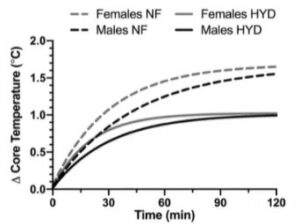
The human body is made up of approximately 60% of water by weight, and that water is distributed differently across various tissues, organs, and bones in the body. Women have about 45-50% water while men have 55-65% water. With this water balance in our bodies, it is not surprising that athletic performance directly correlates to the fluid balance within our bodies.
The ideal balance of fluids in our bodies is called “euhydration balance” and can be viewed as a scale on the picture below:

As long as we don’t tip the scale to one side or the other, our bodies are happy and they function very well. If we introduce imbalance, we have consequences and sometimes pretty severe ones. So how do we keep this euhydration balance in check?
On one side we have water intake, on the opposite side of the fluid balance equation we have a water loss. The main source of water intake comes from ingested fluids, and some water is also obtained through various food sources and from metabolic reactions within the body. Water is lost from the body through urine and feces, through the skin, and as exhaled water vapor. Water contained within the various body tissues is released daily through the skin via sweat. In fact, under normal daily conditions, the body loses approximately 600 mL of water through sweating. In addition to this, approximately 300 mL of water is lost through small water droplets in exhaled air. Finally, approximately 1,300 mL of water is lost through a combination of our urine and feces.
Despite the tight regulation of total body water under normal resting conditions, exercise can result in significant fluid losses due to the increased release of sweat through the skin, which allows heat to escape from the body’s surface by providing a cooling mechanism. Sweat rates can range between 0.25 to 3.0 L/h – that is a huge range! If the lost fluid is not adequately replaced during exercise, athletes will experience large disruptions in total body fluid balance, which poses a threat to both their health and athletic performance.
Adequate water ingestion is responsible for maintaining optimal blood volume. Insufficient water intake or excess water loss through sweat can lead to hypohydration, which results in decreases in blood volume, reductions in blood flow to muscles, and increases in core body temperature due to reduced heat dissipation. The reduction in blood volume, alongside a reduction in plasma volume, increases the viscosity of the blood which affects the capacity of the heart to transport blood to the exercising muscles. While the level of hypohydration that impairs performance is highly dependent on the methods by which hypohydration is achieved and the specific performance task, it is generally well established that dehydration greater than 2% of body weight (BW) is the critical point at which performance is reduced. Here’s an example calculation for our imaginary athlete:
Pre-Exercise Weight – Post-Exercise Weight = BW loss
60 kg (Pre-Exercise Weight) – 57 kg (Post-Exercise Weight) = 3 kg BW loss
BW Loss in kg / Pre-Exercise Weight * 100 = % BW loss
3 (BW Loss in kg) / 60 (Pre-Exercise Weight) × 100 = 5%
This athlete without adequate fluid ingestion would be at risk of dehydration. His/her hydration plan should prescribe fluid intake that aims to prevent dehydration above 2%.
Although sweat is primarily composed of water, it also contains a number of electrolytes and other constituents such as potassium, magnesium, calcium, and sodium. Sodium and chloride are the most common electrolytes lost through sweat, and their losses can cause imbalances that impair performance. But sodium concentration in a person’s sweat is highly individual. An athlete may have low sweat sodium concentrations but still exhibit large sodium losses due to their high sweat rate. In contrast, if high sweat sodium concentrations are accompanied by low sweat rates, then total sodium losses may be relatively low. There are a number of tests available to measure sodium concentration, as simple as a patch on your forearm or sending a sample to a lab. On average sweat contains approximately 50 mmol/L of sodium. As such, sodium losses can be calculated by multiplying total sweat rate by the sodium concentration. For example, an athlete with a sweat rate of 1 L per hour is likely to lose approximately 50 mmol of sodium per hour. This is the equivalent of 1.1 g sodium in 1 L of fluid.
If indications of dehydration are present, it is advised to adopt a rehydration strategy that attempts to restore fluid balance. This can be achieved by consuming fluid at a rate of 150% of body mass losses, adding sodium to reduce urine output, and monitoring symptoms regularly and consistently. While the amount of fluid plays an important role in replacing lost fluids, the composition of such fluids can have a large impact on how much fluid is retained within the body. For example, ingestion of water alone results in a decrease in sodium concentrations within the body and results in a reduced perception of thirst and increased urine output. When combined together, these two factors will only serve to delay the rehydration process. With this in mind, the addition of sodium into the rehydration drink plays an important role by increasing the desire to drink while also ensuring the fluid being consumed is retained within the body and not simply lost through urine. Most commercially available sports drinks contain 10–25 mmol of sodium per liter, which equates to 0.22 g of sodium per 500 ml of fluid for a 20 mmol solution. To create a 30 mmol solution, 0.34 g of sodium per 500 ml of fluid would be required.
One super useful hack that I found for monitoring my own hydration status while training for an Ironman is using Urine Specific Gravity (USG) test. USG provides a comparison of the density of urine to that of water. It estimates the solute concentration of urine and is dependent on the individual’s hydration status and their kidneys’ ability to dilute concentrations to normal levels within the body. Therefore, abnormally high levels may indicate dehydration or high concentrations of salt, whereas abnormally low levels may indicate poor urine concentration regulation by the kidneys. Usual urine specific gravity levels fall between 1.002 and 1.030 Urine Specific Gravity (USG), with water measuring 1.000 USG. A measure of 1.010 USG or above indicates dehydration, and the higher the number, the more severe the dehydration. Every urine test I have seen provides this measure and you can order urine test strips online or pick some up at your local pharmacy. Exercise, pee, check. Simple and effective.
Up to this point, we talked about athletes’ hydration in general but just like my interest in women-specific training, there is something to be said about women-specific hydration. Total body water is the common denominator when we talk about dehydration. Men and women are very different in this area with different percentages of water in their bodies. On average females have 31L and males have 44L. This is partially due to differences in stature and muscle mass. Females have smaller stature, higher percent body fat, which does not contain water, and smaller skeletal and muscle mass that do contain water. Moreover, female hormone fluctuations affect total plasma volume in the body and core temperature and therefore have an effect on the hydration status as well.
Also, interestingly enough, men and women store water within the body in different ways. Men store 60% in their extracellular reserve, 28% intracellular and 12% intravascular. Women have a very different distribution at 49% being extracellular, 39% intracellular, and the same 12% intravascular. This also affects the ability of a body to pull water inside the cells. Men have way more capacity to replenish intracellular water losses by pulling from the extracellular reserve.
Unfortunately, but not surprisingly, most of our understanding of hydration comes from studies done exclusively on men. Some preliminary data suggests that women are affected by dehydration way sooner than men and therefore it is critical for women to start their hydration protocol as soon as possible and not wait until they get thirsty.
One study done on cyclists determined that men showed an increase in core temperature at an hour of exercise and 1.5% of water loss, while women increased their core temperature after only 30 minutes and 0.5% of water loss. Both groups were at 65% of their VO2Max. This is a huge gap! In fact, as you can see from the graph below, men never reached the same level of core temperature or dehydration as women did! This and several other studies advise women to start their hydration protocol as soon as possible.

I am really looking forward to more hydration studies done specifically on women, especially as it relates to our hormone fluctuations. I hope this article helped you understand how to keep our bodies in that ideal euhydration balanced state and also gave you practical ways to calculate the loss threshold so you do not let yourself fall behind the 2% mark.
As always, feedback and comments are welcome and if you’d like a sports nutritionist’s help figuring out your training nutrition needs or race day nutrition planning, feel free to drop me a line.
Stay hydrated!
